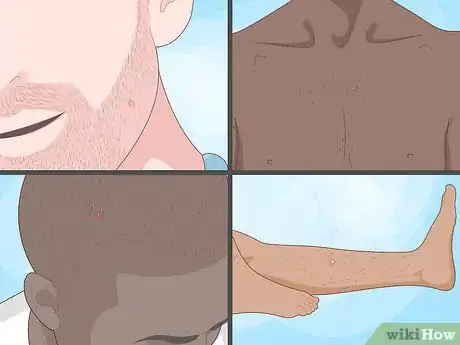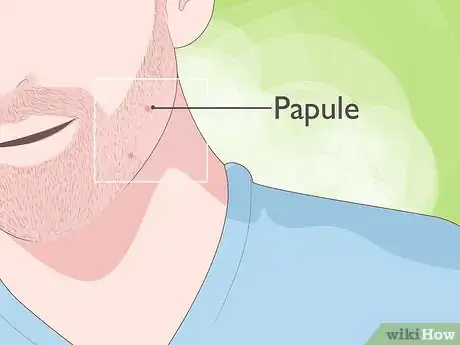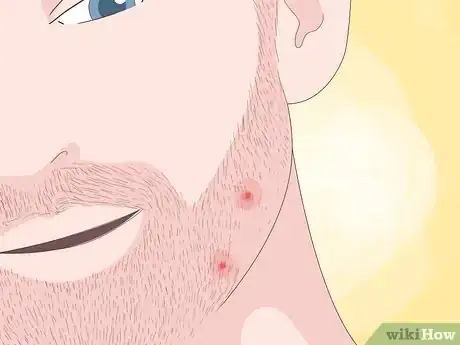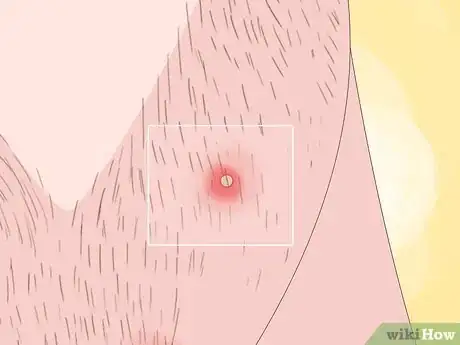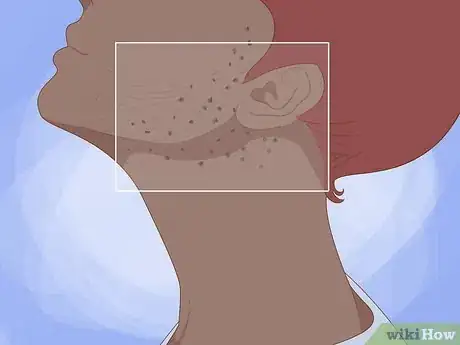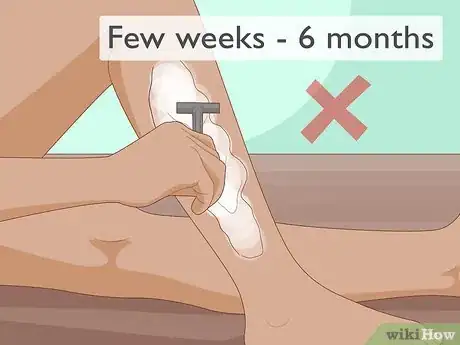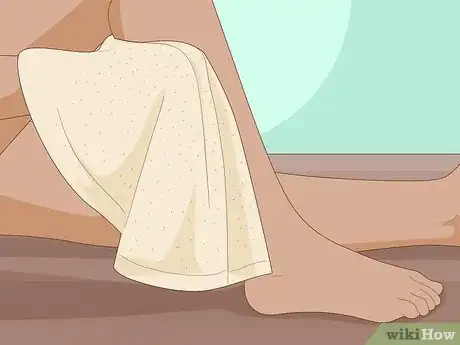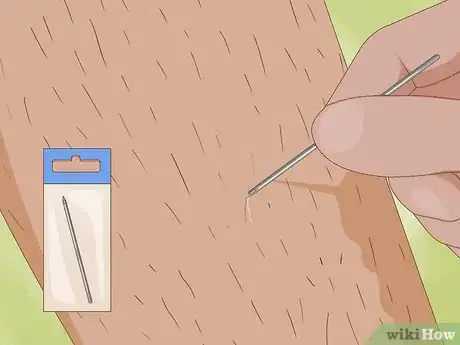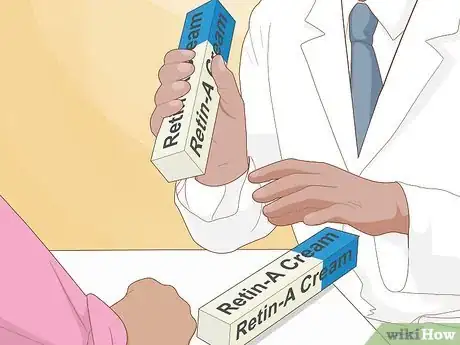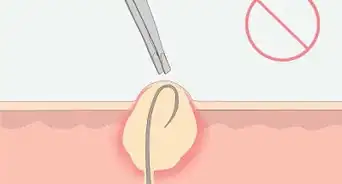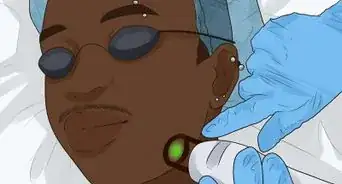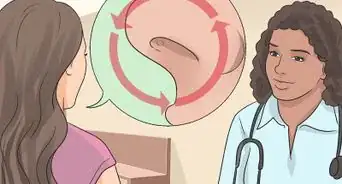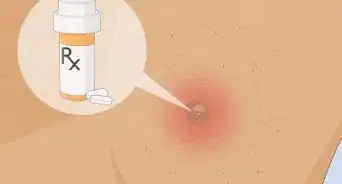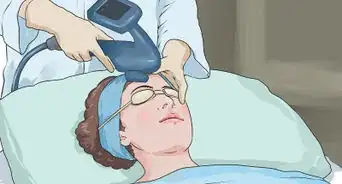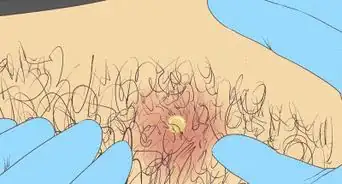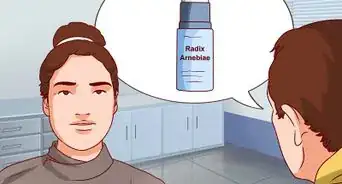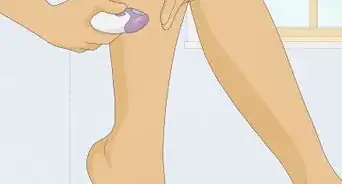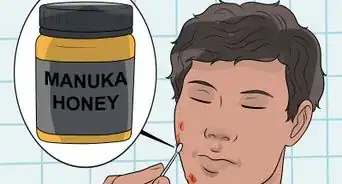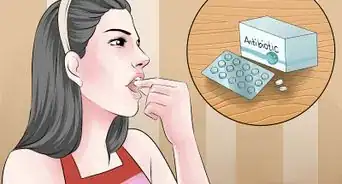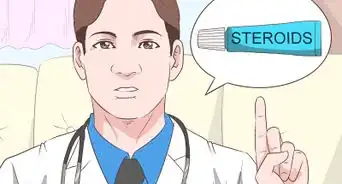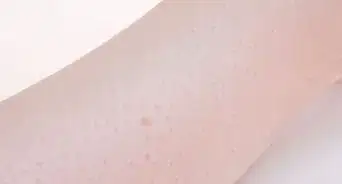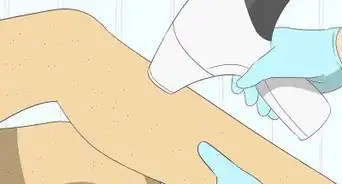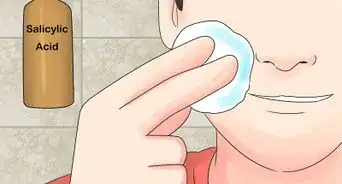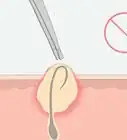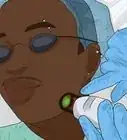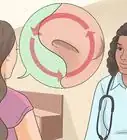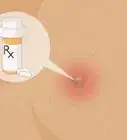This article was medically reviewed by Luba Lee, FNP-BC, MS and by wikiHow staff writer, Megaera Lorenz, PhD. Luba Lee, FNP-BC is a Board-Certified Family Nurse Practitioner (FNP) and educator in Tennessee with over a decade of clinical experience. Luba has certifications in Pediatric Advanced Life Support (PALS), Emergency Medicine, Advanced Cardiac Life Support (ACLS), Team Building, and Critical Care Nursing. She received her Master of Science in Nursing (MSN) from the University of Tennessee in 2006.
There are 9 references cited in this article, which can be found at the bottom of the page.
This article has been viewed 10,534 times.
According to the University of Rochester Medical Center, an ingrown hair is a hair that curls back in on itself and grows in under the skin rather than coming to the surface.[1] You’re most likely to get ingrown hairs in areas where you shave, tweeze, or wax your hair. To spot ingrown hairs, look for telltale red bumps, pustules, or visible hairs beneath the surface of your skin in these areas. If you think you have an ingrown hair, gently exfoliate the area daily to try to release it. Your doctor can also prescribe treatments to help with stubborn ingrown hairs.
Steps
Recognizing the Symptoms of Ingrown Hairs
-
1Watch for ingrown hairs in areas where you shave or remove hair. While you can get an ingrown hair anywhere, you’re most likely to get them in areas where you remove your hair by waxing, shaving, or plucking.[2] Look for ingrown hairs in any areas where you regularly remove hair, such as your:[3]
- Face and neck
- Legs
- Pubic area
- Armpits
- Chest
- Back
- Scalp (if you shave your head)
-
2Look for small red bumps or pustules. The most obvious symptom of ingrown hairs is typically small red bumps, which look and feel similar to pimples. Sometimes these bumps are filled with pus.[4]
Warning: Sometimes an ingrown hair can cause a hardened bump or cyst to form, especially if you have very curly hair. These are known as “razor bumps” or pseudofolliculitis barbae.[5] PFB isn’t dangerous, but it can cause pain, infections, and even permanent scarring if left untreated.[6] Talk to your doctor or dermatologist about treatment options if you think you may have razor bumps.
Advertisement -
3Check for itching and pain. Ingrown hairs are often uncomfortable. If you notice bumps or pustules in areas where you remove hair, check to see if they are also itchy or painful to the touch.[7]
- If the area around an ingrown hair is very painful, swollen, bright red, or hot to the touch, call your doctor. These may be signs of a more serious infection.[8]
-
4Examine your skin for visible trapped hairs. In some cases, you may be able to see a hair embedded under your skin or inside a bump or pustule.[9] Look for a dark line or shadow under the skin.
- Look at your skin in a well-lit area so you’ll have an easier time spotting hairs below the surface.
-
5Keep an eye out for patches of darkened or discolored skin. One common complication of ingrown hairs is darkening of the skin, or hyperpigmentation. Check for small darkened or discolored spots in areas where you expect to find ingrown hairs.[10]
- People with darker skin tones are more likely to get hyperpigmentation from ingrown hairs than people with lighter skin tones.[11]
Treating Ingrown Hairs
-
1Stop removing the hair in the affected area for a few weeks. Ingrown hairs will often clear up on their own, but you need to let your skin rest for a while so it can heal. If possible, don’t shave, wax, or tweeze the area until your ingrown hairs heal up. This may take anywhere from a few weeks to 6 months.[12]
- If you really feel the need to remove hair in the area, try using a gentler method, such as electric clippers or a hair removal cream.[13]
Tip: To remove hair from the area more permanently and prevent future ingrown hairs, consider getting laser hair removal treatments.[14]
-
2Exfoliate the area gently with a washcloth every day. Gentle exfoliation can help remove dead skin cells and eventually release the trapped hair. At least once a day, wash the area for several minutes using warm water and mild soap. Gently scrub the ingrown hair with a washcloth in a circular motion.[15]
- For slightly stronger exfoliation, scrub the ingrown hair with a soft-bristled toothbrush.
- It can also help if you apply a warm compress or rub the area in a circular motion with a warm washcloth.
- Exfoliate while you’re taking a shower or bath since the heat will help open up your pores.
Tip: Apply glycolic or salicylic acid creams to help remove dead skin and expose ingrown hairs so they’re easier to treat.[16]
-
3Tease the hair out with a sterilized needle if it’s close to the surface. If you can see the hair right under the surface of your skin or inside a pustule, you may be able to hook a needle under it to free it. Clean a needle in isopropyl alcohol or hold it in a flame for a few minutes to sterilize it. Gently push the tip of the needle under the hair to pull out a small loop, then free the end of the hair by pulling on the loop with a pair of tweezers.[17]
- If you use a flame to sterilize the needle, allow it to cool down completely before you use it so you don’t burn yourself.
- Resist the urge to pluck the hair out, since it might simply grow in under the surface again. Instead, try cutting it close to the skin with a pair of clippers.
- If you can’t hook the hair right away, don’t keep digging around with the needle. This will only irritate the area more, and it could lead to scarring.
-
4Ask your doctor about medications that might help. If your ingrown hair is very painful, possibly infected, or not responding to home treatments, talk to your doctor or a dermatologist. They may be able to prescribe medications or other treatments to help you heal faster.[18]
- Your doctor might prescribe a steroid cream to reduce inflammation and swelling.
- If the ingrown hair isn’t coming out on its own or responding to gentle exfoliation, there are medications that can help remove dead cells from the surface of your skin and free the trapped hair. Your doctor may prescribe a retinoid cream, such as Retin-A or Renova.
- If the area around the hair is infected, you might need to take an oral or topical antibiotic to clear it up.
Warnings
- Ingrown hairs can look similar to other skin conditions, such as bug bites, pimples, infected hair follicles, or lesions from a sexually transmitted disease (such as herpes). If you’re not sure what’s causing the bumps on your skin, see your doctor for a diagnosis.⧼thumbs_response⧽
References
- ↑ https://www.urmc.rochester.edu/encyclopedia/content.aspx?ContentTypeID=85&ContentID=P00294
- ↑ https://dermatology.ca/public-patients/hair/ingrown-hair/
- ↑ https://www.nhs.uk/conditions/ingrown-hairs/
- ↑ https://www.mayoclinic.org/diseases-conditions/ingrown-hair/symptoms-causes/syc-20373893
- ↑ https://www.aocd.org/page/pseudofolliculitisb
- ↑ https://www.uspharmacist.com/article/pseudofolliculitis-barbae-prevention-and-treatment
- ↑ https://www.mayoclinic.org/diseases-conditions/ingrown-hair/symptoms-causes/syc-20373893
- ↑ https://www.nhs.uk/conditions/ingrown-hairs/
- ↑ https://www.nhs.uk/conditions/ingrown-hairs/
- ↑ https://www.mayoclinic.org/diseases-conditions/ingrown-hair/symptoms-causes/syc-20373893
- ↑ https://health.clevelandclinic.org/qa-expert-explains-best-way-handle-ingrown-hair/
- ↑ https://www.mayoclinic.org/diseases-conditions/ingrown-hair/diagnosis-treatment/drc-20373898
- ↑ https://www.nhs.uk/conditions/ingrown-hairs/
- ↑ https://www.mayoclinic.org/diseases-conditions/ingrown-hair/diagnosis-treatment/drc-20373898
- ↑ https://www.mayoclinic.org/diseases-conditions/ingrown-hair/diagnosis-treatment/drc-20373898
- ↑ https://www.ncbi.nlm.nih.gov/pubmed/8261811
- ↑ https://www.mayoclinic.org/diseases-conditions/ingrown-hair/diagnosis-treatment/drc-20373898
- ↑ https://www.mayoclinic.org/diseases-conditions/ingrown-hair/diagnosis-treatment/drc-20373898
